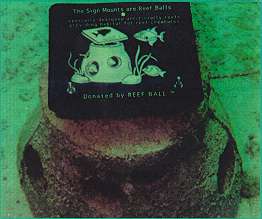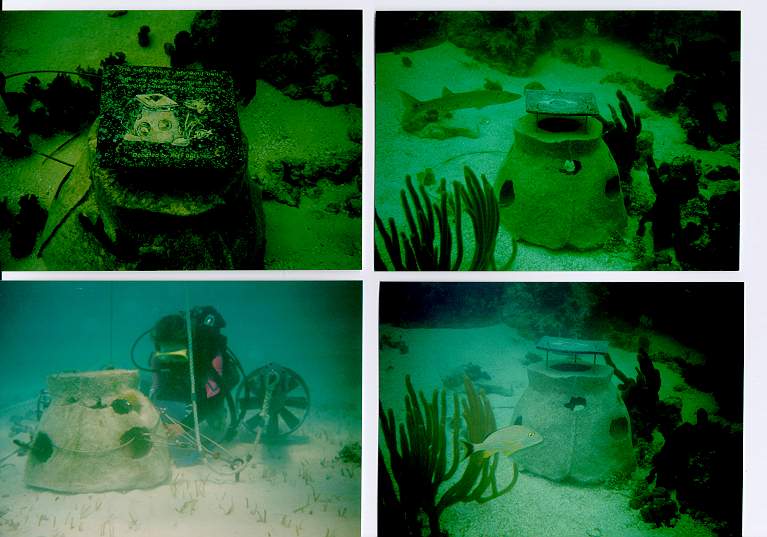 Sea
Systems, A Division of PARDEE, Ltd.
Sea
Systems, A Division of PARDEE, Ltd.
P.O. Box 43
Providenciales, Turks and Caicos Islands
(649) 946-5578
email: 75601.604@compuserve.com

In 1995, an estimated 79,000 tourists visited Turks and Caicos Islands (TCI), 73,500 of whom stayed on TCI's island of Providenciales, generating an estimated income of more than $12 million in tourism dollars for the islands.
Some of these weary tourists come to the Turks and Caicos seeking the "world's finest beaches." Even more come in search of the islands' "pristine reefs, abundant marine life and excellent visibility." These features make TCI a "worid class diving and snorkeling destination," featured in many dive and snorkel publicatiions
The islands are arrayed around the edges of two large limestone plateaus which comprise 6,964 kilometers of island habitat, 93% of this is underwater bank habitat. It is no wonder so many flock to experience its stunning reef systems and beauty.
Coral reefs are often referred to as the "rain forests of the oceans" because they sustain nearly 25% of all marine species and represent some of the most magnificent living systems in the world Coral reefs also support vibrant tourism economies, protect beaches and shorelines from erosion, act as nurseries for growing fish and provide a critical sources of food and income for millions of people. How approprate that 1997 was celebrated as the "Year of the Reef," drawing loog-overdue recognition to these vital habitats.
So Much Reef With Minimal Access
The Turks and Caicos are graced with a tourism economy which relies on its coral reefs as a central attraction for visitors. Upon arriving at the hotel and tourism accomidations, tourists face a dilemma how to access these watery gardens. The truth ofthe matter is there are few or none with close proximity to hotel accommodations. Most tourists will find that they must again pack and pay for a remote trip in pursuit of these remarkable reefs.
Sea Systems is asking the question, instead of trucking tourist to a remote reef location, why not bring the reef system to tourist?
 Reef Discovery Sites
Reef Discovery Sites
Coral reefs are known to take hundreds of years to form, as a result these natural systems cannot rebuild themselves fast enough to meet human demands. Long lasting, natural looking artificial reefs are useful tools for restoring our existing ecosystems and providing alternate reef sites which in turn reduce the diver load on the natural reefs.
By providing a jump-start on the structural building process, properly constructed and located artificial reef units will quickly become natural looking Reef Discovery Sites. Artificial reef structures provide many benefits, as they:
- Furnish alternative snorkeling and diving sites, diverting impact pressures from natural reefs and allow these systems to rebuild and flourish;
- Provide a more convenient constructed location accessible to diving enthusiasts;
- Provide an educational snorkel/dive trail with information regarding coral reef ecology, as well as conservation ethics and stewardship for reef communities; and
- Promotes TCI as an ecotourism destination worldwide.

In an effort to promote the importance and use of artificial reefs to the resort industry, Sea Systems' principals are prepared to work with individual clients to minimize their capitol outlay for the development and establishment of Reef Discovery Sites. Four phases are suggested for the establishment of those sites, including:
1) Project assessment surveys, conceptual development and government permitting issues;
2) Fabrication and deployment;
3) Post-project assessment surveys; and
4) Long-term monitoring.
Reef Balls TM
Fiberglass Mold
The Reef Ball Development Group has devised a patented fiberglass mold system for the construction of artificial reefs (as seen in foreground of the photo at the top of this page). Reef Balls TM are hollow, dome-shaped structures designed to imitate the natural reef structures (as seen in the background of the same photo). The units are marine friendly concrete combined with additives used to create a super strong, abrasion resistant concrete with a pH similar to ocean water. Properly constructed and deployed, Reef Balls_ have an expected life of 500 years or more. They are engineered for underwater stability and minimal impact to surrounding areas.
Reef Ball TM Unit
Each Reef Ball has its own unique hole sizing and placement, with surface textures that enhance settlement of marine life. Once deployed, Reef Discovery Sites will begin to come to life through various natural processes. Almost immediately, fish and other marine creatures will migrate into this new habitat, searching for safe havens. The unique Reef Ball TM design provides just that. Primary growth, consisting of a myriad of marine algae will flourish within the first few months, nurtured by the inputs and outputs of the more mobile species.
 Snorkel
Trails
Snorkel
Trails
Artificial reef snorkel trails at the Reef Discovery Sites will include a series of Reef Ball TM arrays situated within the 100 meter non-navigation zone just off the resort's beach. Each array will contain Reef Ball TM units ranging in size from the 'Lo-Pro' unit (1.5'x 2.5') to the 'Pallet Ball' unit (3'x 4'). An individual array will consist of anywhere from 2-5 Reef Ball units of varying size. Each site along the trail will have an educational theme denoted through an underwater sign constructed within the pod of Reef BallsTM. Buoys and/or underwater flags may be used to denote the location of the sites and floating rest stops may desired for novice swimmers.
Sea Systems Principals' & Expertise
Sea Systems, a division of PARDEE, Ltd. is a Turks and Caicos-registered
company committedto the Preservation of Aquatic Resources & the Development
of Ecological Enterprises.
The principals of Sea Systems have a combined total of more than 50 years
of experience working in the marine science field while working with
institutional, governmental, nongovernmental organizations, and private sector
interests. The range of their experiences includea multitude of marine-orientated
projects that span the geographic regions of the world.
Coastal Engineering & Scientific Data Collection
Lee E. Harris, PhD., P.E. is a registered professional civil and coastal
engineer and resides as Associate Professor of ocean engineering and oceanography
at the Florida Institute of Technology in Melbourne, Florida .Dr. Harris
has extensive experience in artificial reef and offshore breakwater engineering
systems. His hands-on approach to projects has included pre-project surveying
and data collection, as well as post-project performance assessment.
Construction & Environmental Monitoring
Kathy Fitzpatrick, P.E. is a registered professional civil and coastal
engineer and currently the District Engineer for the Sebastian Inlet Tax
District Commission (SITD) in Indialantic, Florida. Ms. Fitzpatrick has a
strong background in permitting of coastal construction projects
inenvironmentally sensitive areas. At SITD, she is primarily responsible
for supervising construction and environmental monitoring projects.
Biological Assessment & Environmental Education
Marsha Pardee Woodring, Msc., works as a biological consultant in the
field of marine ecology, aquaculture and environmental management. She is
currently the Project Coordinator for several projects administered through
the Turks and Caicos National Trust, including the developmentof educational
snorkel trails on Providenciales, TCI.
Each member of the Sea Systems team demonstrates experience in the different
aspects of developing artificial reef systems, whether it be in design,
engineering, construction, deployment, formation of educational information,
permitting and or environmental monitoring of projects indiverse demographic
regions. Collectively, the Sea Systems team has amassed the essential experience
needed to efficiently design and construct artificial reef projects with
an integrated
eco-educational dimension anywhere in the world. Their affiliation and ongoing
interaction with Reef Ball Development Group on numerous projects as an
authorized contractor, assure contemporary proficiency in artificial reef
systems and their deployment. A close working relationship with talented
artisans specializing in images of the undersea world insures that interpretive
elements of educational artificial reef systems are of quality and original
artworks.
Reef Ball Development Group, Ltd. Expertise
RBDG of Sarasota, Florida, is an all volunteer group dedicated to saving
our oceans ecosystems through the development of new ideas, techniques and
devices designed to create aesthetically pleasing, ecologically sound artificial
reefs.
The Reef Ball Development Group, Ltd. is currently conducting more than 30
projects worldwide adding Reef Balls to restore the world's oceans at a rate
of over 1,000 Reef Balls per month. Project teams (such as the Boy Scouts
of America, Department of Natural Resource Protection, Atlantis Submarine,
Royal Caribbean Cruise Lines, high schools, diving and fishing clubs, National
Association of Underwater Instructors (NAUI), marine institutes, universities
and many others) have built reefs in Cancun, Mexico, Islamorada, The Florida
Keys, Key Biscayne National Park, Fort Landerdale, Florida, Sarasota, Florida,
Savannah, Georgia, St.Catherine Island, Georgia, Hilton Head Island South
Carolina, Charleston, South Carolina, Myrtle Beach, South Carolina, Sussex,
England, Qatar, the United Arab Emirates and hundreds of other locations.
RBDG has also built test and research reefs throughout the world. Additional,
Reef Balls are being combined in sea wall, dock, breakwater, and recreational
pier projects. Other applications include uses in bays, canals and estuaries.
Reef Balls represent the world's most advanced artificial reef technology.
Studies continue by universities to develop new applications for Reef Balls
and to improve current uses.
 Sea
Systems, A Division of PARDEE, Ltd.
Sea
Systems, A Division of PARDEE, Ltd.
P.O. Box 43
Providenciales, Turks and Caicos Islands
(649) 946-5578
email: 75601.604@compuserve.com
This page has been accessed times since 1/5/98
Copyright ©1995 & 1996, 1997, 1998 RBDG, Ltd. and Sea Systems All rights reserved. See brochure page footer for information on patents, copyrights, trademarks and service marks referenced, but not indicated, on this page. As a service to CORALations, Inc., the Reef Ball Development Group, Ltd. has donated the programming and space for CORALation's home page on the Internet. The Reef Ball Development Group, Ltd. and CORALations Inc. are separate companies.
